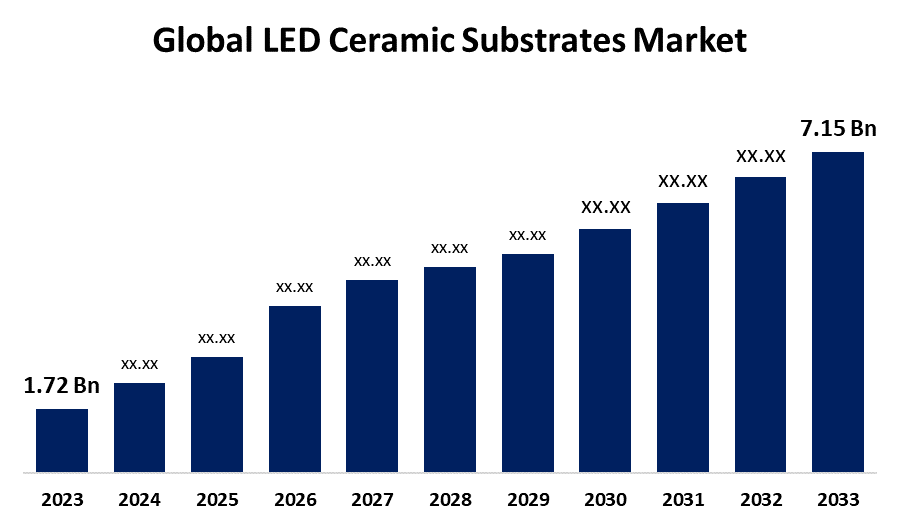Global LED Ceramic Substrates Market Size, Share, and COVID-19 Impact Analysis, By Material Type (Aluminum Nitride (ALN), Aluminum Oxide (Al2O3), and Others), By Application (Electrical Applications, Automotive Industry, and Wireless Communications), and By Region (North America, Europe, Asia Pacific, Latin America, Middle East, and Africa), Analysis and Forecast 2023 - 2033.
Industry: Semiconductors & ElectronicsGlobal LED Ceramic Substrates Market Insights Forecasts to 2033
- The Global LED Ceramic Substrates Market Size was Valued at USD 1.72 Billion in 2023
- The Market Size is Expected to Grow at a CAGR of around 15.31% from 2023 to 2033
- The Worldwide LED Ceramic Substrates Market Size is Expected to Reach USD 7.15 Billion by 2033
- Asia Pacific is Expected to Grow the fastest during the forecast period.

Get more details on this report -
The Global LED Ceramic Substrates Market Size is anticipated to Exceed USD 7.15 Billion by 2033, growing at a CAGR of 15.31% from 2023 to 2033.
Market Overview
The global LED ceramic substrates market encompasses companies that manufacture of ceramic substrates of LED, which are essential for energy-efficient light solutions. The market for LED ceramic substrates is a segment of the semiconductor industry, focused on the production of materials for high-performance LED applications. Additionally, the growing use of LEDs in the automotive sector is another important factor propelling market expansion. The need for long-lasting and effective lighting solutions has grown as a result of the industry's quick transition to electric vehicles (EVs) and smart lighting systems. Due in large part to its great performance and energy economy, LED lighting is becoming more and more popular in automobile applications like headlamps, interior illumination, and signal lights. Because of their superior heat management capabilities, ceramic substrates are essential for automotive LED applications since they provide dependability and efficiency, which helps the market grow. Furthermore, the need for ceramic substrates in LED applications has increased as a result of the continuous roll-out of 5G infrastructure in telecoms, which has raised the necessity for components that can withstand greater frequencies and power levels.
Report Coverage
This research report categorizes the global LED ceramic substrates market based on various segments and regions forecasts revenue growth and analyzes trends in each submarket. The report analyses the key growth drivers, opportunities, and challenges influencing the global LED ceramic substrates market. Recent market developments and competitive strategies such as expansion, product launch, and development, partnership, merger, and acquisition have been included to draw the competitive landscape in the market. The report strategically identifies and profiles the key market players and analyses their core competencies in each sub-segment of the global LED ceramic substrates market.
Global LED Ceramic Substrates Market Report Coverage
| Report Coverage | Details |
|---|---|
| Base Year: | 2023 |
| Market Size in 2023: | USD 1.72 Billion |
| Forecast Period: | 2023-2033 |
| Forecast Period CAGR 2023-2033 : | 15.31% |
| 2033 Value Projection: | USD 7.15 Billion |
| Historical Data for: | 2019-2022 |
| No. of Pages: | 230 |
| Tables, Charts & Figures: | 100 |
| Segments covered: | By Material Type, By Application and By Region |
| Companies covered:: | Noritake, Vishay, NCI, Tong Hsing, ICP Technology, Ecocera, Xellatech, Maruwa, CeraTron, Jiangsu Fulehua, Folysky, and Others. |
| Pitfalls & Challenges: | COVID-19 impact, Challenge, Future, Growth, & Analysis |
Get more details on this report -
Driving Factors
The global market for LED ceramic substrates is being driven by the rising dependency on energy-efficient and sustainable electric products. The demand for LED light solutions is increasing due to the government and many organizations encouraging the adoption of environmentally friendly technologies. For instance, energy-efficient lighting could cut electricity use in the United States by around 50% by 2030, according to a report by the Energy Information Administration (EIA). This trend accelerates the growth and development of highly efficient ceramic substrates, which are crucial for increasing LED productivity and reducing heat generation. Additionally, technical innovations in material science have led to the evolution of new ceramic composites that improve the LEDs' performance. Due to their higher electrical insulation and thermal conductivity, materials like aluminum nitride (AlN) are being used more and more. Furthermore, the market for LED ceramic substrates is being driven mostly by the quick technical developments in consumer electronics and telecommunications. Better LED components are in greater demand as a result of the widespread use of smart devices and the requirement for high-performance lighting in laptops, tablets, and smartphones.
Restraints & Challenges
The market is vulnerable to some challenges that could affect its rate of expansion. One of the main obstacles is the high price of sophisticated ceramic materials like beryllium oxide and aluminum nitride. Despite providing better thermal management, these materials are more costly to produce, which can prevent them from being used in situations where cost is a concern.
Market Segmentation
The global LED ceramic substrates market share is classified into material type and application.
- The aluminum nitride (AlN) segment held a significant share in 2023 and is expected to grow at a significant CAGR during the forecast period.
Based on the material type, the global LED ceramic substrates market is categorized as aluminum nitride (AlN), aluminum oxide (Al2O3), and others. Among these, the aluminum nitride (AlN) segment accounted for a significant share in 2023 and is expected to grow at a significant CAGR during the forecast period. The remarkable electrical insulation and thermal conductivity of aluminum nitride (AlN) make it a material of choice for LED ceramic substrates. AlN substrates are frequently utilized in high-power LED applications, where reliable and effective heat dissipation is essential to performance.
- The electrical applications segment held a significant share in 2023 and is expected to grow at a significant CAGR during the forecast period.
Based on the application, the global LED ceramic substrates market is categorized as electrical applications, automotive industry, and wireless communications. Among these, the electrical applications segment held a significant share in 2023 and is expected to grow at a significant CAGR during the forecast period. This is mostly because commercial lighting systems, industrial equipment, and consumer electronics all have a significant demand for energy-efficient lighting solutions. High-performance lighting solutions require LED ceramic substrates because of their higher heat conductivity and dependability for electrical applications.
Regional Segment Analysis of the Global LED Ceramic Substrates Market
- North America (U.S., Canada, Mexico)
- Europe (Germany, France, U.K., Italy, Spain, Rest of Europe)
- Asia Pacific (China, Japan, India, Rest of APAC)
- South America (Brazil and the Rest of South America)
- The Middle East and Africa (UAE, South Africa, Rest of MEA)
North America is projected to hold the largest share of the global LED ceramic substrates market over the forecast period.

Get more details on this report -
North America is projected to hold the largest share of the global LED ceramic substrates market over the forecast period. A significant consumer of LED ceramic substrates, the US has made significant investments in innovation and technology. The region's emphasis on sustainability and energy efficiency, bolstered by legislative measures, propels the uptake of LED lighting options. Further propelling market expansion is the sophisticated healthcare infrastructure and focus on infection control, which encourages the usage of LEDs in medical devices.
Asia Pacific is expected to grow at the fastest CAGR growth of the global LED ceramic substrates market during the forecast period. With substantial production facilities for electronic products and LED components, nations including China, Japan, South Korea, and India are important market contributors. The need for LED ceramic substrates is driven by the region's robust manufacturing base, technical developments, and government programs that support sustainability and energy efficiency. With rising awareness of infection prevention and cleanliness, the healthcare industry is growing, which helps the Asia-Pacific market expand.
Competitive Analysis:
The report offers the appropriate analysis of the key organizations/companies involved within the global LED ceramic substrates market along with a comparative evaluation primarily based on their product offering, business overviews, geographic presence, enterprise strategies, segment market share, and SWOT analysis. The report also provides an elaborative analysis focusing on the current news and developments of the companies, which includes product development, innovations, joint ventures, partnerships, mergers & acquisitions, strategic alliances, and others. This allows for the evaluation of the overall competition within the market.
List of Key Companies
- Noritake
- Vishay
- NCI
- Tong Hsing
- ICP Technology
- Ecocera
- Xellatech
- Maruwa
- CeraTron
- Jiangsu Fulehua
- Folysky
- Others
Key Target Audience
- Market Players
- Investors
- End-users
- Government Authorities
- Consulting And Research Firm
- Venture capitalists
- Value-Added Resellers (VARs)
Market Segment
This study forecasts revenue at global, regional, and country levels from 2020 to 2033. Spherical Insights has segmented the global LED ceramic substrates market based on the below-mentioned segments:
Global LED Ceramic Substrates Market, By Material Type
- Aluminum Nitride (ALN)
- Aluminum Oxide (Al2O3)
- Others
Global LED Ceramic Substrates Market, By Application
- Electrical Applications
- Automotive Industry
- Wireless Communications
Global LED Ceramic Substrates Market, By Regional
- North America
- US
- Canada
- Mexico
- Europe
- Germany
- UK
- France
- Italy
- Spain
- Russia
- Rest of Europe
- Asia Pacific
- China
- Japan
- India
- South Korea
- Australia
- Rest of Asia Pacific
- South America
- Brazil
- Argentina
- Rest of South America
- Middle East & Africa
- UAE
- Saudi Arabia
- Qatar
- South Africa
- Rest of the Middle East & Africa
Frequently Asked Questions (FAQ)
-
1. What is the CAGR of the global LED ceramic substrates market over the forecast period?The global LED ceramic substrates market size is expected to grow from USD 1.72 Billion in 2023 to USD 7.15 Billion by 2033, at a CAGR of 15.31% during the forecast period 2023-2033.
-
2. Which region is expected to hold the highest share of the global LED ceramic substrates market?North America is projected to hold the largest share of the global LED ceramic substrates market over the forecast period.
-
3. Who are the top key players in the global LED ceramic substrates market?Kyocera, Noritake, Vishay, NCI, Tong Hsing, ICP Technology, Ecocera, Xellatech, Maruwa, CeraTron, Jiangsu Fulehua, Folysky, and Ledstar Tech, and others.
Need help to buy this report?